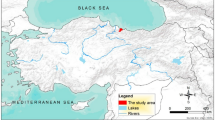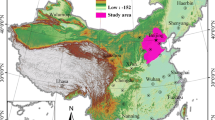Abstract
Soil organic carbon (SOC) plays an important role in the global carbon cycle. The aim of this study was to evaluate the response of SOC to land use change and its influence on land use planning in the Haihe basin, and provide planning land use pattern for basin flood risk assessment. Firstly, the areas of different land use types in 1980, 2008, and the planning year (2020) were counted by area statistics function of ArcGIS. Then, the transfer matrixes of land use were produced by spatial overlay analysis function. Lastly, based on the land use maps, soil type map and soil profile database, SOC storage of different land use types in three different periods were calculated. The results showed the patterns of land use have changed a lot from 1980 to 2008, among the 19,835 km2 of grassland was transformed into forestland, which was the largest conversion landscape. And land use conversion brought the SOC storage changes. Total carbon source was 88.83 Tg, and total carbon sink was 85.49 Tg. So, the Haihe basin presented as a carbon source from 1980 to 2008. From 2008 to 2020, the changes of forestland and grassland are the biggest in Haihe basin, which cause the SOC pool change from a carbon source to a carbon sink. SOC storage will increase from 2420.5 Tg in 2008 to 2495.5 Tg in 2020. The changing trend is conducive to reducing atmospheric concentrations. Therefore, land use planning in Haihe basin is reasonable and can provide the underlying surface condition for flood risk assessment.







Similar content being viewed by others
References
Batjes, N. H. (1996). Total carbon and nitrogen in the soils of the world. European Journal of Soil Science, 47, 151–163.
Bell, M. J., Worrall, F., Smith, P., Bhogal, A., Black, H., Lilly, A., Barraclough, D., & Merrington, G. (2011). UK land-use change and its impact on SOC: 1925–2007. Global Biogeochemical Cycles, 25(4), 4015.
Cerria, C. E. P., Easterb, M., Paustianb, K., Killianb, K., Colemanc, K., Bernouxd, M., Falloone, P., Powlsonc, D. S., Batjesf, N., Milneg, E., & Cerria, C. C. (2007). Simulating SOC changes in 11 land use change chronosequences from the Brazilian Amazon with RothC and Century models. Agriculture, Ecosystems & Environment, 122(1), 46–57.
Chakan, A. A., Mehrjardi, R. T., Kerry, R., Kumar, S., Khordehbin, S., & Khanghah, S. Y. (2017). Spatial 3D distribution of soil organic carbon under different land use types. Environmental Monitoring and Assessment, 189, 131.
Fallahzade, J., & Hajabbasi, M. A. (2012). The effects of irrigation and cultivation on the quality of desert soil in central Iran. Land Degradation & Development, 23(1), 53–61.
Gainza-Carmenates, R., Altamirano-Cabrera, C. J., Thalmann, P., & Drouet, L. (2010). Trade-offs and performances of a range of alternative global climate architectures for post-2012. Environmental Science and Policy, 13(1), 63–71.
Li, C. J., Li, Y., Ma, J., Fan, L. L., & Wang, Q. X. (2010). Spatial heterogeneity of soil chemical properties between Haloxylon persicum and Haloxylon ammodendron populations. Journal of Arid Land, 2(4), 257–265.
Maia, S. M. F., Ogle, S. M., Cerri, C. E. P., & Cerri, C. C. (2009). Effect of grassland management on soil carbon sequestration in Rondonia and Mato Grosso states, Brazil. Geoderma, 149(1–2), 84–91.
Maia, S. M. F., Ogle, S. M., Cerri, C. E. P., & Cerri, C. C. (2010). Soil organic carbon stock change due to land use activity along the agricultural frontier of the southwestern Amazon, Brazil, between 1970 and 2002. Global Change Biology, 16(10), 2775–2788.
Milne, E., Adamat, R. A., Batjes, N. H., Bernoux, M., Bhattacharyya, T., Cerri, C. C., Cerri, C. E. P., Coleman, K., Easter, M., Falloon, P., Feller, C., Gicheru, P., Kamoni, P., Killian, K., Pal, D. K., & Paustian, K. (2007). National and sub-national assessments of soil organic carbon stocks and changes: the GEFSOC modelling system. Agriculture, Ecosystems & Environment, 122(1), 3–12.
Poeplau, C., Don, A., Vesterdal, L., Leifeld, J., Wesemael, B. V., Schumacher, J., & Gensior, A. (2011). Temporal dynamics of soil organic carbon after land-use change in the temperate zone-carbon response functions as a model approach. Global Change Biology, 17(7), 2415–2427.
Post, W. M., Emanuel, W. R., Zinke, P. J., & Stangenberger, A. G. (1982). Soil carbon pools and world life zones. Nature, 298(5870), 156–159.
Salvati, L., Barone, P. M., & Ferrara, C. (2015). Exploring the multiplicity of soil-human interactions: organic carbon content, agro-forest landscapes and the Italian local communities. Environmental Monitoring and Assessment, 187, 283.
Singh, A., Santra, P., Kumar, M., Panwar, N., & Meghwal, P. R. (2016). Spatial assessment of soil organic carbon and physicochemical properties in a horticultural orchard at arid zone of India using geostatistical approaches. Environmental Monitoring and Assessment, 188, 529.
Sreenivas, K., Sujatha, G., Sudhir, K., Vamsi, K. D., Fyzee, M. A., Ravisankar, T., & Dadhwal, V. K. (2014). Spatial assessment of soil organic carbon density through random forests based imputation. Journal of the Indian Society of Remote Sensing, 42(3), 577–587.
The National Soil Survey Office (1993–1996). Soil species of China (Vol. 1-Vol. 6). Beijing: China Agricultural Press (In Chinese).
The National Soil Survey Office. (1998). Soils of China. Beijing: China Agricultural Press (In Chinese).
Watson, R. T., Noble, I. R., Bolin, B., Ravindramath, N. H., Verardo, D. J., & Dokken, D. J. (2000). Land use, land use change and forestry (p. 375). Cambridge: Cambridge University Press.
Xu, N., Meng, W. Q., Zhai, F. Q., & Li, H. Y. (2013). Effects of land use change on ecosystem service value in Tianjin Binhai new area. Urban Environment & Urban Ecology, 26(1), 5–8 (in chinese).
Yu, D. S., Shi, X. Z., & Sun, W. X. (2005). Estimation of China soil organic carbon storage and density based on 1:1,000,000 soil database. Chinese Journal of Applied Ecology, 16(12), 2279–2283 (In chinese).
Zhang, X. Z., Zhao, X. L., Li, H. L., Wang, Z. J., Lao, X. G., & Xie, W. M. (2011). Research on organic carbon storage and sequestration mechanism of soils in the Heibei Plain. Earth Science Frontiers, 18(6), 41–55.
Zhang, J., Wang, X. J., & Wang, J. P. (2014). Impact of land use change on profile distributions of soil organic carbon fractions in the Yanqi Basin. Catena, 115, 79–84.
Acknowledgments
The authors would like to acknowledge the financial support for this work provided by the National Key Research and Development Program of China (Grant no. 2016YFC0401407), the National Natural Science Foundation of China (Grant no. 51579169) and the Ministry of Water Resources Special Funds for Scientific Research on Public Causes (201401041).
Author information
Authors and Affiliations
Corresponding author
Rights and permissions
About this article
Cite this article
Li, F., Wang, L. & Zhao, Y. Evolvement rules of basin flood risk under low-carbon mode. Part I: response of soil organic carbon to land use change and its influence on land use planning in the Haihe basin. Environ Monit Assess 189, 377 (2017). https://doi.org/10.1007/s10661-017-6101-5
Received:
Accepted:
Published:
DOI: https://doi.org/10.1007/s10661-017-6101-5




